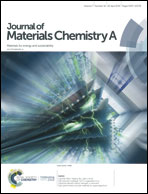Nanoporous gold supported chromium-doped NiFe oxyhydroxides as high-performance catalysts for the oxygen evolution reaction†
Abstract
Development of versatile electrodes that boost the sluggish kinetics of the oxygen evolution reaction (OER) is crucial for electrochemical water splitting with high efficiency. Here we present monolithic hybrid electrodes of chromium-doped NiFe oxyhydroxide nanosheets, which are quasi-vertically oriented along three-dimensional nanoporous gold (NP Au/Cr–NiFe), as high-performance OER electrocatalysts in an alkaline environment. As a result of incorporation of chromium ions that prefer to locate near the electroactive Fe sites in the NiFe oxyhydroxides, the intrinsic activity and turnover frequency value of the constituent Cr–NiFe oxyhydroxide are significantly enhanced relative to those of the NiFe hydroxide by a factor of ∼4 at an overpotential of 0.340 V. As a result of the unique nanoarchitecture featuring both the quasi-vertical orientation of highly electroactive Cr–NiFe oxyhydroxide nanosheets, which offer abundant active edge sites, and the bicontinuous nanoporous channels and gold skeleton, which facilitate ion and electron transport, the NP Au/Cr–NiFe electrodes exhibit high and stable OER activity in a 0.1 M KOH solution, with an ultralow Tafel slope of ∼33 mV dec−1 and an overpotential of 0.323 V at 10 mA cmgeo−2.



 Please wait while we load your content...
Please wait while we load your content...